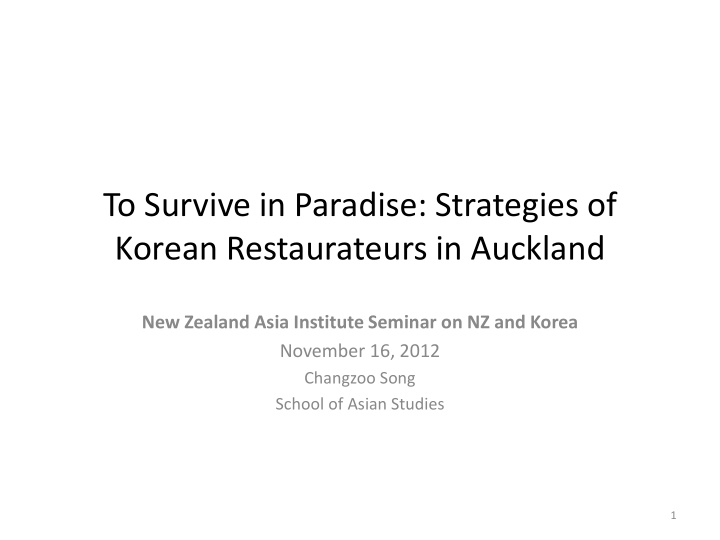



To Survive in Paradise: Strategies of Korean Restaurateurs in Auckland New Zealand Asia Institute Seminar on NZ and Korea November 16, 2012 Changzoo Song School of Asian Studies 1
Portraits of Korean Immigrants in New Zealand • Koreans are envious of Korean New Zealanders – Clean environment, good education system, leisurely life style… • Indeed, Korean immigrants have enjoyed their life in New Zealand • However, with low employment rate and income, many have ben struggling • “A total crisis in NZ Korean community” (on-going sense of crisis expressed in NZ Korean newspapers) 2
Blue sky… 3
Koreans in Census • The 2006 New Zealand census: 30,792 Koreans in NZ • Third-largest Asian population after Chinese and Indians • Most Koreans in NZ live in the Auckland region (70%) • Majority of them living in the North Shore (70%) • Young – nearly half under 25 years of age • One third of them are unemployed, the highest among five Asian groups • This reflects the challenges they face in adapting to different environment in NZ. 4
Socio-economic Adjustments in New Zealand • Korean immigrants experience occupational down- shifting • High level of self-employment (higher than Chinese migrants) – “Kimchi Networks: Korean Employers and Employees in Auckland” by C. Meares, E. Ho, R. Peace & P. Spoonley (Massey University, 2010) • Why such high self-employment rate? – Language barriers – Economic disadvantage – Only low wage jobs available to them and sense of relative status-lowering – Ethnic and class resources 5
Ethnic entrepreneurship (self-employment) Factors influencing business entry • – Economic disadvantage (push factors): lack of language skills, prejudice – Cultural predisposition (pull factors): entrepreneurial traditions of the ethnic group – Contextual factors: ethnic resources, opportunities, class resources, ethnic enclaves Ethnic Resources • – Access to inexpensive and reliable labour, i.e. family members – Access to cheaper finance (i.e., ethnic credit association such as gye ) – In the case of ethnic Koreans, supports from homeland government is increasingly important (proactive diasporic policies of South Korea: voting rights to overseas Koreas; allowing dual nationalities; networking Korean diasporas and so on) Class Resources: education, capital • 6
Cases of Ethnic Entrepreneurship in the Americas Very high self-employment rate (in the US highest among Asian • immigrants) Finding ‘ethnic business niche’ and establishing ‘ethnic hegemony’ • (controlling most of the processes in the business): (1) Dry cleaning business in the US; (2) Garment industry in Latin America; and (3) Sushi business in the US to a certain degree Success Factors • Conventional Factors -- Economic Disadvantage, Ethnic Resources, Ethnic enclave, – Middleman minority strategies, Niche seeking based on ethnic and class resources – Historical and international economic environmental factors : 7
Garment and sushi: historical and global economic environmental factors • Garment Industry – Timing: Old, retiring migrants (Jews) and new and younger migrants (Koreans) in North and South America – Changes in global economic environment • Fabric production shift from Europe to Asia • Korea’s dominance in garment manufacturing and fabric production – Existence of cheap labour: Illegal Latino migrants in the US • Bolivian migrants in Argentine • • Sushi business Culinary cultural changes in the West and soaring demand in sushi in the late 1980s – Aging and shortage of Japanese immigrants – Colonial legacies in Korea – 8
Perceived Problems in NZ business environment • Small market • Language barrier • Racism and discrimination • Competition among Koreans (and Asians) • “Conservativeness” of the main stream culture 9
Business Environment for Koreans in NZ • August 2012 Good Day New Zealand reports: • About 2,000 Korean businesses listed in Auckland • Koreans concentrated on 10 businesses 10
Concentrated on 10 business Business Details Number Construction Building, painting, plumbing, flooring … 220 Restaurants Korean, Japanese, Chinese, cafes 200 Real estate agent 170 Religious organisations Christianity, Buddhism and others 150 Hair salon & skin care 130 Health food stores 120 Groceries & marts 100 International students About 9,000 Korean international students 90 services in Auckland Automobile Service, accessory.. 70 Cleaning 50 11
Korean Restaurants: changes • Food related industry in NZ - Monthly 300 million • Korean-owned restaurants in Auckland 200 • Before 2000: 3-4 big restaurants for Korean tourists • 2000-2005: Increasing number but only catering Koreans • 2005-2007: Toughening competition – Some moved to Japanese restaurants – But, the number continuously increasing • 2007-2009: many restaurants went bankrupt (30% closed) – More localised restaurants appeared (cafes, bars…) • 2009-present: increasing sizes – Specialisation (BBQ rib, sundae soup…) – New generation owners appeared 12
Strategies: moving to Japanese food 13
14
Strategies: Aiming for Chinese 15
16
17
New Trends: de-ethnicisation 18
De-ethnicisation 19
Other Trends • Utilising Hallyu as a resource • Bringing new ideas from Korea: specialised menu, transnationalism • Expanding to other ethnic market – Sushi – Aiming for Chinese New Zealanders • De-ethnicisation – Fusion foods – Aiming for main stream 20
21
From Puffer Restaurant to… 22
Kangnam Style Buffet Restaurant 23
Going mainstream: lunch bars, cafes, and bars 24
25
Conclusion • Korean ethnic entrepreneurialism • Continuous changes and adaptations • Strategies: Ethnicisation, de-ethnicisation, Japanisation Sinicisation, assimilation, transnationalism • Only 20 years of business history and still in the process of adjusting • Eventually will find niches while adapting to the changing realities • Contributing to the enrichment of culinary culture of New Zealand 26
Recommend
More recommend